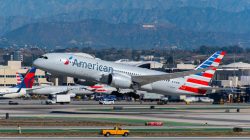First 787 to launch in May to Chicago, followed by Buenos Aires and Beijing in June
American Airlines first three 787 will all originate or terminate from its largest base at DFW airport. The first 787-800 was delivered to AA on January 22 of this year and the carrier has placed firm orders for 42 more. The carrier will receive 11 additional 787s through the end of 2015.
The first 787 route to launch will be from Dallas/Ft. Worth to Chicago O’Hare on May 7, as is typical for an airline to deploy new widebody aircraft on domestic short-haul routes between its major hubs for maintenance purposes in case a last-minute aircraft swap is needed and readily available. Coincidentally, May 7 is also the launch date of American’s new route from Dallas/Ft. Worth to Beijing, which will switch from operating as a Boeing 777-200ER to a 787 on June 2. American’s 3rd 787 route will commence on June 4 from Dallas/Ft. Worth to Buenos Aires, Argentina.
Related: American grows international network after highly profitable FY2014
The choice of deploying the 787 on two intercontinental routes from its largest base is logical given that the flight schedules between Dallas – Asia and Dallas – South America compliment each other nicely to permit good utilization rates from an operations perspective. American’s flight from Beijing arrives into DFW at 17:00, and its flight to Buenos Aires departs at 21:50. The return flight from Buenos Aires arrives into DFW at 5:22 AM and the outbound flight into Beijing leaves at 10:40 AM.
In short, the airframes are scheduled to arrive and depart from DFW with slightly less than 5 hours on the ground, assuming that American will rotate the aircraft between the two markets. American’s flights to deep South America, such as Buenos Aires, tend to spend a day on the ground as premium traffic prefers overnight flights on long-haul routes within similar time zone geographies. As such, at Buenos Aires, the 787 will likely be towed to a remote stand for roughly 8 hours or so.
Deployment of 787 on Buenos Aires as an inital candidate presents interesting data points
Given the fact that Beijing is a new route and Chicago is domestic, the use of the 787 on the DFW to Buenos Aires route provides a more thorough analysis into what AA seeks to accomplish from a revenue and yields perspective.
American has operated nonstop service between Dallas/Ft. Worth and Buenos Aires since November 2003, and traditionally rotated between a 767 during the off-season (May through October) and a 777-200ER during the peak season, but in recent years has maintained gauge on a 777 year-round. The current layout on American’s 3-class 777s, all of which are undergoing a retro-fit to 2-class cabins, feature 16 seats in Flagship First, 37 in Business and 194 in Economy, resulting in approximately 1,729 weekly seats each way between DFW and Buenos Aires.
The 787 configuration, as outlined by American today, will feature 28 seats in Business class and 198 in Economy, of which 48 are Main Cabin Extra seats. Overall, this represents a loss of 21 seats per day each way (or 147 seats weekly) and a nearly 48% reduction in premium cabin offerings. In theory, the premium cabin layout mirrors that of American’s retrofitted 767 fleet, which will see 28 flat bed seats on offer (2 fewer than the former configuration) and 181 main cabin seats (7 fewer than before), although of these, only 18 Main Cabin Extra seats will be offered compared to 48 on the 787.
This suggests that American is content with greatly reducing its premium cabin offering in favor of a higher-density plane with more extra legroom seats on offer. What is interesting is, the 787 will offer the most main cabin extra seats of any of American’s widebody aircraft. American’s 777-300ER currently offers the highest number at 30 MCE seats, whereas its retro-fitted 2-class 777-200ERs offer 45 seats.
In essence, this places the 787 nicely betweend American’s 767 fleet and 777-200ER fleet, with roughly the same number of premium class seats on offer between the 787 and 767 (28) but roughly the same number of main cabin extra seats on offer between the 787 and 777-200ER (48 vs. 45). Said another way, the 787 will be used on routes where there is a larger demand for a premium economy product than can be satisfied by a 767, but not large enough for a 777. The main cabin of American’s 777 can hold up to 20 additional passengers and much more cargo than the 787.
Beijing route will see 787 to help offset upstart costs
The Dallas/Ft. Worth to Beijing flight will only offer First Class seats for a few weeks before the 777 is swapped out for a 787, a smart move given that with a larger-density and more premium-cabin offering, the route would likely require more time to mature. It is also a much safer way to trial the 787 on a newer, rather than established, route with fewer advanced bookings to see how the market responds.
Rocky has published a more in-depth article on the seat features and cabin amenities in each travel class, and American announced that the flights would be available for booking in the GDS on February 14.
Over the next coming weeks, more routes will be announced, and it is assumed that the 787 will similarly take over 767 routes that are not ideal 777 candidates, supposedly a selection of transatlantic routes out of New York JFK such as Zurich and Paris. It will also be interesting to watch where American chooses to deploy its 787-900 routes, and whether or not the carrier decides to include First class, even as it continues to remove First from the majority of its long-haul fleet.



